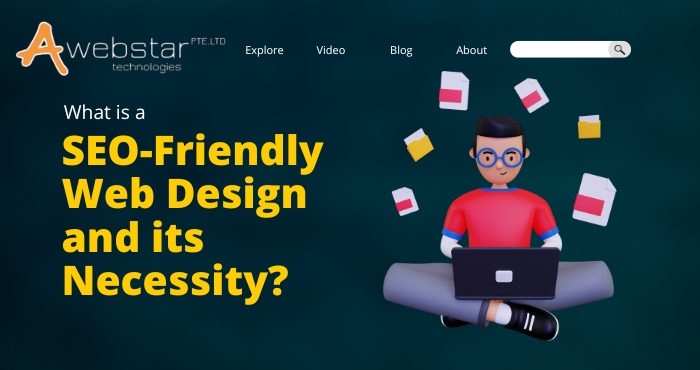
In the present digital era, the creation of a website to captivate visitors & achieve a high ranking on search engine results is paramount. Search Engine Optimisation (SEO) has become an essential element in setting up a strong online presence. Such a well-optimised website is fundamentally necessary for attracting organic traffic. This would generate more leads as the number of visitors increases. Consequently, both SEO and website design help your brand to make a lasting impression on your visitors together.
This blog post will shed some light on the need for SEO-friendly websites. Furthermore, it will take into consideration the various essential factors required to design an SEO- friendly website. Further, it will be followed by various elements involved in designing these websites. So, let us commence on this journey of SEO optimisation. Discover the basic guidelines to make a search engine-friendly website to drive relevant traffic.
Come along and achieve your online goals in 2023 with us!!
What is a SEO-Friendly Web Design and its Necessity?
SEO-friendly website design refers to the practice of creation and optimisation of a website design in such a way that enhances its visibility. The website ultimately gets ranked on search engine results pages (SERPs). The main purpose of this is to make the website more accessible, user-friendly and appropriate to the target audience.

Basically, it involves strategically involving various elements and design principles to align with search engine algorithms and user preferences. The necessity of SEO-friendly web design stems from the fact that we all primarily depend on search engines as primary sources of information.
It tackles both technical and user-oriented aspects of a website. On the technical front, it involves optimizing page speed, implementing proper URL structures, and managing duplicate content. For this purpose, it uses schema markup for enhanced search result appearance.
While from the user perspective, SEO-Friendly Design focuses on delivering an exceptional user experience. This entails designing a responsive and mobile-friendly website, creating an intuitive navigation system, and using well-structured headers to organise content effectively.
Achieve Technical Excellence for Your Website
The following section emphasises achieving technical excellence for your website. Come along as we discuss these in the section below.
Url Structure And Site Architecture
A clear and organised URL structure makes it easy for search engines to index your pages. Employing descriptive and keyword-rich URLs can multiply your website’s visibility in search results.
Consequently, a thoughtfully planned site architecture with a logical hierarchy helps search engines understand the relationships between different pages and content categories.
Fully Indexable Pages
Indexable pages are those that search engine bots can access to ultimately include in their databases. This makes them eligible to appear in search results. Search engines crawl your website to discover and analyse its content. This ultimately determines its relevance to users search queries. Subsequently, you increase your website’s visibility and the chances og getting indexed.
However, note that usage of elements like Flash, JavaScript or other technologies may hinder search engines from reading and understanding your content.
Make Sure You’re Using Https
A secure version of HTTP that encrypts data exchanged between the website and its visitors is Hypertext Transfer Protocol Secure. This encryption boosts your website’s credibility and trustworthiness in the eyes of both users and search engines.
HTTPS can positively impact your search engine rankings as Google considers it as a ranking signal.
Use the Canonical Tag
Basically, the canonical tag is an HTML element that helps identify duplicate content issues. It can lead to confusion when search engines encounter similar or identical content across multiple pages. Thus, it can further dilute your website’s search visibility. You can specify the preferred version of a page by simply including the canonical tag.
This indicates search engines which URLs should be indexed and displayed in search results. Implementing the canonical tag streamlines your website’s indexing process and enhances its overall SEO performance. These tags optimise your website for better search engine visibility.
SSL Encryption And Website Security
An SSL certificate protects user information such as personal details and payment data. It also instils confidence in your visitors that safeguards sensitive data from potential threats. This further leads to increased trust and credibility.
It is a vital SEO factor as major search engines prioritize websites with SSL encryption. To ensure a seamless and safe browsing experience for users regularly update and secure your website against vulnerabilities, malware and cyberattacks.
Designing SEO-Friendly Website Essentials Elements
The main aspect of designing a website is that it must be SEO-friendly. The following section outlines the essential elements required for designing an SEO-friendly website. Let us take a look at it.

Create and Submit XML Sitemap
An XML sitemap is a file that lists all the essential pages of your website while helping search engines to index your site more effectively. You can use various online tools or plugins depending on your website platform.
You must ensure that the sitemap includes all important pages including the homepage, key service page, product page, blog posts and other relevant content. Once the XML sitemap is ready submit it to search engines and regularly update and resubmit the sitemap. This way you will be able to improve the search engine visibility of your website.
Setting Up Robots.txt
These files typically act as a set of instructions for search engine crawlers that guides them on which URLs they can access on your site. It prevents overloading your website with unnecessary requests and thus improves crawl efficiency. To block indexing of specific pages you can use the “no index” meta tag or password-protect the page. You can thus enhance your SEO performance and provide a seamless user experience for your visitors
Improper configurations may block search engines from accessing critical parts of your site leading to a negative impact on SEO. Ensure your site follows the on-page SEO checklist to avoid such issues.
Implementing Breadcrumbs And Site Links
Breadcrumbs are a navigation aid displaying the hierarchical trails of pages leading to the current page.This makes it easier for users to understand their position within the website’s structure. They enhance user experience and provide search engines with a clear understanding of your site’s organization thus improving indexing.
The additional links that appear in the search engine results are below the main website link. These typically lead to essential pages on your website that provides users with quick access to relevant sections. By implementing breadcrumbs and having search engines display site links, you can enhance your website’s visibility and user-friendliness.
Awesome User Experience
In order to provide a seamless user experience the following points should be taken care of. Let us discuss them one by one.
Mobile-friendly Design
A mobile-friendly design ensures that your website adapts to different screen sizes that make navigation and interaction effortless for mobile users. Visitors can access your content easily with a mobile-friendly layout and fast-loading pages.
This leads to increased engagement and higher satisfaction. Additionally, it improves your website’s overall usability, performance and success.
Optimize images
To complement the content high-quality visuals must be employed to evoke emotions, create connections and leave a lasting impression on users. Furthermore, visual storytelling, emphasizing key points and implementing interactive elements can make the user experience more enjoyable and immersive. It is necessary to do image optimization for quick loading.
Make sure your site loads fast
Users expect instant access to information. A slow-loading site can frustrate visitors and drive them away resulting in higher bounce rates and missed opportunities. Minimize HTTP requests and leverage browser caching to achieve a fast-loading website.
To distribute your content across multiple servers consider using a content delivery network that reduces latency and improves global loading times.
Optimising Design for Voice Search
Many virtual assistants like Siri, Alexa and Google Assistant are gaining popularity. Majority of users are using voice commands to search for information. Businesses must adapt their website design to be voice-search-friendly. Ensure mobile-friendliness and fast-loading pages as voice searches often occur on mobile devices.
Clear and Intuitive Navigation
Visitors expect to find information easily and navigate seamlessly through your content. A well-organised and user-friendly navigation menu ensures that users can quickly locate the pages or sections. This reduces frustration and encourages them to explore more. It’s worthwhile to keep content simple and consistent across all pages. All this contributes to driving sales, gathering leads and sharing valuable content.
Working on Core Web Vital issues
For delivering an awesome user experience on a website working on core web vital issues, Google uses a set of specific metrics to assess a site’s performance. It is calculated in terms of loading speed, interactivity and visual stability.
Largest Contentful Paint (LCP)
This feature determines the perceived loading speed and overall user experience of a website. Websites should aim to achieve an LCP of 2.5 seconds or faster. You can successfully optimise page loading times by compressing images, leveraging browser caching and optimising server response times to improve LCP.
First Input Delay(FID)
FID is a critical indicator of a website’s interactivity and user engagement. A good FID score is considered to be less than 100 milliseconds. It is advised to streamline Javascript execution and minimise long tasks that may hinder user interactions for FID.
Cumulative Layout Shift(CLS)
It directly impacts user experience. A good CLS score should be less than 0.1. Tackle CLS issues by ensuring that elements do not unexpectedly shift causing a frustrating experience for users.
Integrating Social Media and SEO
Businesses can take advantage of social media platforms to improve their search engine rankings and drive more organic traffic to their website. As an indicator of a website’s popularity and relevance, social media signals such as likes, shares and comments are considered by search engines. This can relevantly make or break your SEO rankings. Furthermore, sharing high-quality content on social media can maximise backlinks thus enhancing SEO performance.
In order to establish a strong visual identity consistent branding across all social media profiles establishes a strong visual identity. Implementation of clear and visually appealing CTAs encourages user engagement and drives them to take action. You can further establish a sense of community and authenticity by telling your brand’s story through design and incorporating user-generated content.
Conclusion
In a nutshell, it is essential to craft an SEO-friendly website design in 2023 for online success. Prioritising mobile responsiveness, creating engaging content, optimizing site speed, using structured data, and integrating social media with SEO are key principles to follow.
Awebstar Technologies specializes in SEO services and is a leading Singapore web design agency that can significantly boost your online visibility. This heightened visibility can result in a substantial increase in sales, leading to a multiplied revenue for your business.















































